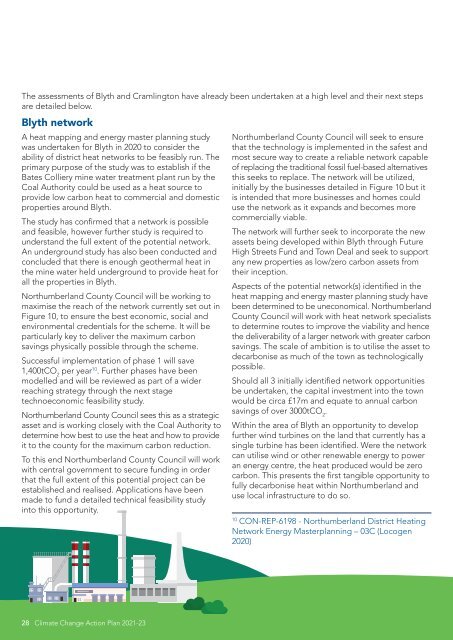Climate change action plan 2021-23
Climate change action plan 2021-23
Climate change action plan 2021-23
Create successful ePaper yourself
Turn your PDF publications into a flip-book with our unique Google optimized e-Paper software.
The assessments of Blyth and Cramlington have already been undertaken at a high level and their next steps<br />
are detailed below.<br />
Blyth network<br />
A heat mapping and energy master <strong>plan</strong>ning study<br />
was undertaken for Blyth in 2020 to consider the<br />
ability of district heat networks to be feasibly run. The<br />
primary purpose of the study was to establish if the<br />
Bates Colliery mine water treatment <strong>plan</strong>t run by the<br />
Coal Authority could be used as a heat source to<br />
provide low carbon heat to commercial and domestic<br />
properties around Blyth.<br />
The study has confirmed that a network is possible<br />
and feasible, however further study is required to<br />
understand the full extent of the potential network.<br />
An underground study has also been conducted and<br />
concluded that there is enough geothermal heat in<br />
the mine water held underground to provide heat for<br />
all the properties in Blyth.<br />
Northumberland County Council will be working to<br />
maximise the reach of the network currently set out in<br />
Figure 10, to ensure the best economic, social and<br />
environmental credentials for the scheme. It will be<br />
particularly key to deliver the maximum carbon<br />
savings physically possible through the scheme.<br />
Successful implementation of phase 1 will save<br />
1,400tCO 2<br />
per year 10 . Further phases have been<br />
modelled and will be reviewed as part of a wider<br />
reaching strategy through the next stage<br />
technoeconomic feasibility study.<br />
Northumberland County Council sees this as a strategic<br />
asset and is working closely with the Coal Authority to<br />
determine how best to use the heat and how to provide<br />
it to the county for the maximum carbon reduction.<br />
To this end Northumberland County Council will work<br />
with central government to secure funding in order<br />
that the full extent of this potential project can be<br />
established and realised. Applications have been<br />
made to fund a detailed technical feasibility study<br />
into this opportunity.<br />
Northumberland County Council will seek to ensure<br />
that the technology is implemented in the safest and<br />
most secure way to create a reliable network capable<br />
of replacing the traditional fossil fuel-based alternatives<br />
this seeks to replace. The network will be utilized,<br />
initially by the businesses detailed in Figure 10 but it<br />
is intended that more businesses and homes could<br />
use the network as it expands and becomes more<br />
commercially viable.<br />
The network will further seek to incorporate the new<br />
assets being developed within Blyth through Future<br />
High Streets Fund and Town Deal and seek to support<br />
any new properties as low/zero carbon assets from<br />
their inception.<br />
Aspects of the potential network(s) identified in the<br />
heat mapping and energy master <strong>plan</strong>ning study have<br />
been determined to be uneconomical. Northumberland<br />
County Council will work with heat network specialists<br />
to determine routes to improve the viability and hence<br />
the deliverability of a larger network with greater carbon<br />
savings. The scale of ambition is to utilise the asset to<br />
decarbonise as much of the town as technologically<br />
possible.<br />
Should all 3 initially identified network opportunities<br />
be undertaken, the capital investment into the town<br />
would be circa £17m and equate to annual carbon<br />
savings of over 3000tCO 2<br />
.<br />
Within the area of Blyth an opportunity to develop<br />
further wind turbines on the land that currently has a<br />
single turbine has been identified. Were the network<br />
can utilise wind or other renewable energy to power<br />
an energy centre, the heat produced would be zero<br />
carbon. This presents the first tangible opportunity to<br />
fully decarbonise heat within Northumberland and<br />
use local infrastructure to do so.<br />
10<br />
CON-REP-6198 - Northumberland District Heating<br />
Network Energy Master<strong>plan</strong>ning – 03C (Locogen<br />
2020)<br />
28<br />
<strong>Climate</strong> Change Action Plan <strong>2021</strong>-<strong>23</strong>
















